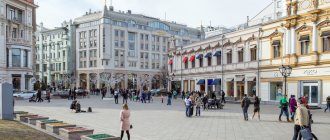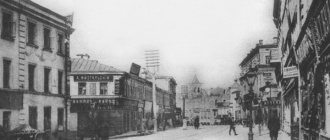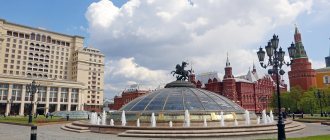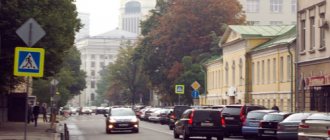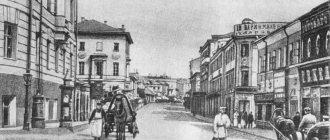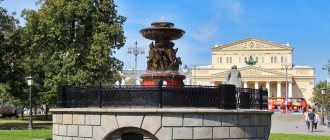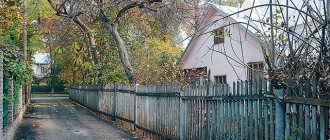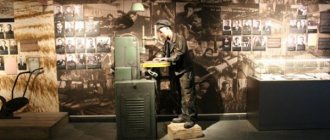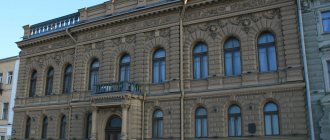History of Tverskoy Boulevard
The “Projected Plan of Moscow of 1775” contained the initial project for the development of Tverskoy Boulevard.
In 1782, the wall of the White City was demolished at this site, but the boulevard itself was built only 14 years later, in 1796. The work was supervised by architect S. Karin.
The alley was first planted with birch trees. These trees did not take root and linden trees were planted in their place. Over time, maples, oaks, elms, spruce and thuja were added to them.
Gradually, the street was lined with classic mansions of that era, and the boulevard became a favorite walking place for Muscovites.
In 1812, Tverskoy Boulevard was severely damaged due to a severe fire that occurred in Moscow when Napoleon's army entered the city.
As a result of the natural disaster, noble mansions were severely damaged.
The French soldiers who set up camp on the territory of the boulevard also contributed to the devastation of the area. They cut down almost the entire avenue of trees and used them for firewood. After these events, Tverskoy was restored in a fairly short time. In addition to newly planted trees, it was improved with green gazebos and fountains, and various bridges. The monument to the great poet A.S. Pushkin on Tverskoy Boulevard was erected in 1880.
In the 80s, a horse-drawn city railway was laid along the street, which was replaced by tram rails in 1911.
At the end of the 19th century, noble mansions of the classical style were replaced by apartment buildings made in the Art Nouveau and eclectic styles.
LiveInternetLiveInternet
For a long time - since the 14th century - the busy Tver Road ran from the Kremlin to Tver. Gradually, this road was built up on its initial section, an area known in the history of Moscow as Zaneglimenye
(that is, “the area located
beyond
the Neglinnaya River”) - turned into a street.
In the 18th-19th centuries, Tverskaya Street
was the main street of the city. The best houses, hotels, and shops in Moscow were built here. On a high place, at the steep descent of the street to the Neglinka River, the outstanding Russian architect M. F. Kazakov built a palace in 1782 for the Moscow Governor-General Z. G. Chernyshev. Reconstructed during Soviet times, this building became the seat of the Moscow City Council of People's Deputies. Now it houses the capital's mayor's office. Here, on Tverskaya, the first horse-drawn railway line in Moscow was laid, in common parlance - “horse horses”.
Open a volume of Pushkin’s “Eugene Onegin” and you will see the appearance of old Tverskaya Street in Moscow:
| ...Let's go! Already the pillars of the outpost are turning white; Now along Tverskaya the cart is rushing through potholes. Booths, women, boys, benches, lanterns flash past. Palaces, gardens, monasteries, Bukharians, sleighs, vegetable gardens, Merchants, shacks, men, Boulevards, towers, Cossacks, Pharmacies, fashion stores, Balconies, lions on the gates And a flock of jackdaws on crosses. |
In 1932, Tverskaya and 1st Tverskaya-Yamskaya streets, which continued after Triumfalnaya Square, were renamed Gorky Street in honor of the writer Maxim Gorky. During the period of social reform in 1990, that part of Gorky Street, which is located between Manezhnaya and Triumfalnaya squares, acquired its historical name - Tverskaya, and the second part, going to Tverskaya Zastava Square, to the Belorussky Station, since 1990 has again been called 1st Tverskaya -Yamskaya. In 1951, a monument to Gorky was unveiled in the park near the station. The renaming of practically the most important street in Moscow during the writer’s lifetime was associated with the return of Maxim Gorky to the USSR from Italy, where he was in a kind of emigration from 1921 to 1928; enthusiastic crowds of Muscovites greeted him at the Belorussky, then Brest, station. Stalin gave this gift—the name of the street—to Gorky, officially “in connection with the 40th anniversary of his literary and social activity,” and unofficially as a reward for supporting the established totalitarian regime.
The time has come to remember the origin of the name of the northwestern Russian city, which was reflected in both the name of Tverskaya Street and the name of Tverskoy Boulevard. An unambiguous explanation of the etymology of the word Tver
does not exist.
The toponym Tver was first
mentioned in the Suzdal Chronicle in 1209, and is found in some sources (for example, in ancient documents and in the 1st Novgorod Chronicle) in the form Tkhvr. The presence of such a variant opened up a wide field for hypotheses about its origin.
Famous historians of the Russian language - Academician A. A. Shakhmatov and Academician A. I. Sobolevsky brought together the word Tkhvr
with the toponym Tikhvin, the name of a city and fortress in Northwestern Rus' (in the current Leningrad region).
And since the cities of both Tver and Tikhvin received their names from the rivers on the banks of which they were located, the hydronyms (river names) that became their basis can be explained as “a river with a calm, quiet flow,” i.e., “quiet.” On the other hand, the presence of the local name of the river and lake Tikhvera
gives etymologists the basis to bring the word
Tver
to the Baltic-Finnish, pre-Slavic toponym
Tihvera.
There is another assumption, the authors of which connect the name of the city of Tver with the Polish word
twierdza
“fortress” and the Lithuanian
word tvora
“fence”.
The oldest Moscow boulevard, Tverskaya, was named after Tverskaya Street.
Each geographical name - regardless of its historical and linguistic value - has a complex of stable associations and so-called background knowledge, that is, information behind a specific toponym and fixed in the minds of a specific person or group of people - from a family and a small group of colleagues to the population of the entire city or even countries. The more significant the object to which the toponym refers, the older its name, the richer or more unusual its historical and cultural biography, the more stable associations this toponym has. We've already talked a little about this.
For me, like many Muscovites, the name Tverskoy Boulevard is associated not only with the concepts of “ancient Moscow”, “the ring of Moscow boulevards”, “the boulevard facing Tverskaya Street and Pushkinskaya Square”, but also with ideas about Russian literature, its history and characters, about prominent Russian writers and poets, Russian drama.
Judge for yourself. On Tverskoy Boulevard and nearby there are three famous Moscow theaters - the Moscow Art Theater. M. Gorky, Theater named after. A. S. Pushkin and the Theater on Malaya Bronnaya, as well as the memorial museum of the great actress M. N. Ermolova.
There is also a building here that Muscovites usually call “Herzen’s house” - Alexander Ivanovich Herzen was born in it, this house was described by him in “History and Thoughts”. Later, a literary salon arose in it, where Aksakov, Belinsky, Gogol, and Granovsky visited. Since 1920, the house was transferred to organizations of Russian writers, and Vs. lived here. Ivanov, Mandelstam, Platonov, Sergeev-Tsensky, Sobolev, other writers; Yesenin, Mayakovsky, Gorky performed. Since 1934, this house has housed the world-famous Literary Institute named after. A. M. Gorky. No less meaningful is that part of the biography of Tverskoy Boulevard in which it acts as a setting or a character in the literary works themselves. And it is no coincidence that one of the recognized experts on literary Moscow, A. A. Shamaro, dedicated a special chapter in his small book “The action takes place in Moscow. Literary topography" specifically on Tverskoy Boulevard. A few examples from those works that I hope you know, or at least whose authors you know.
Tverskoy became the setting for Lermontov's satirical poem "Boulevard". The plot topography of L. N. Tolstoy’s play “The Living Corpse” is connected with Tverskoy. Tverskoy is mentioned in the novels of Leo Tolstoy: three daughters of the Shcherbatskys - Dolly, Natalie and Kitty - walked here, accompanied by a footman and governess; Pierre Bezukhov rode along the same boulevard in a sleigh to the house of Marya Dmitrievna Akhrosimova, not yet knowing about Natasha Rostova’s reckless act. On Tverskoy Boulevard, former university student Yakov Aratov was waiting for the young actress Klara Milich in Turgenev’s story “Klara Milich (After Death).” The action of one of Chekhov’s best stories, “The Seizure,” begins on Tverskoy Boulevard. More than once, as a full-fledged character, Tverskoy Boulevard is present in Alexei Tolstoy’s trilogy “Walking Through Torment”. Remember? Every evening the sisters went to Tverskoy Boulevard to listen to music, sit on a bench and watch girls and teenagers in white and pink dresses walking under the trees - a lot of women and children; less often did a military man pass by with his arm bandaged, or a disabled person on a crutch.” This is how the writer depicts the last summer of the former Russia - a year before the October Revolution of 1917. On Tverskoy, the sisters met their former St. Petersburg idol, the poet Bessonov, who was going to the front. Later on the boulevard, Dasha Telegina meets with the leader of the conspiracy, Boris Savinkov: “The trees of Tverskoy Boulevard, the gloomy and rare passers-by floated as if through fog.” Without a doubt, the “Herzen House” on Tverskoy became an almost complete prototype of the “Griboyedov House” with its noisy literary fraternity from Bulgakov’s novel “The Master and Margarita”.
Connoisseurs of Russian literature still believe (in this case I share the opinion of Alexander Shamaro) that the most poetic lines dedicated to Tverskoy Boulevard are those that begin Bunin’s story “Mitya’s Love” and the beginning of the heartbreaking story of tragic love at the Pushkin monument: “ Winter suddenly gave way to spring, it was almost hot in the sun. It was as if the larks had really arrived and brought with them warmth and joy. Everything was wet, everything was melting, drops were dripping from the houses... High clouds dispersed into thin smoke, merging with the damp blue sky. Pushkin towered in the distance with blissful thoughtfulness.” Yes, the monument to A.S. Pushkin actually stood before not in its current location, but on the other side of Strastnaya (Pushkinskaya) Square, at the very beginning of Tverskoy Boulevard. But we'll talk about this a little later.
Tverskoy Boulevard is the oldest of Moscow boulevards: it was the first to be built in the summer of 1796 on the site of the ten-kilometer wall of the White City, erected in 1586 at the behest of Ivan the Terrible’s son, Tsar Fyodor, and by the mid-18th century had lost its defensive significance. Historians do not know exactly who was the author of the idea to lay out the boulevards along the line of the White City - as it was said in the highest decree of 1774, “the place under that former city (i.e. the wall. - M.G.
) leveled and planted with trees to beautify the city, and use excess rubble and earth for the benefit of the inhabitants.” Most Moscow experts are inclined to believe that this was suggested by one of the brilliant architects who surrounded Empress Catherine II - V. I. Bazhenov, V. V. Rastrelli, I. E. Starov. However, in reality, the first Moscow boulevard appeared only twenty years later - under Paul I. This was Tverskoy, which celebrated its bicentennial in the summer of 1996!
Tverskoy Boulevard, lined with linden trees and located in one of the central parts of Moscow inhabited by the nobility, quickly turned into a purely “Moscow” corner of the capital city. Here is what Yu. A. Fedosyuk writes about him in his book “Moscow in the Garden Ring”: “Very soon the boulevard became a favorite walking place for the Moscow nobility. There is information that poor people, at least at the height of the festivities, were not allowed here. Moscow nobles called the boulevard their “green club.” Meetings of acquaintances, business and love dates took place here, regulars exchanged news and gossip, girls of marriageable age cast their gazes at the romancing officers and young officials, mothers whispered mysteriously, looking for worthy grooms among the fashionable helipads... By 1830, other boulevards of the ring had already appeared, however Tverskoy never lost its glory.”
There is a widespread tradition in Russian toponymy according to which alleys and boulevards facing a large street often repeat its name in their name. This happened with Tverskoy Boulevard - it got its name from Tverskaya Street, from which it began.
Moscow boulevards, and the first of them - Tverskoy - cannot but evoke feelings of love for our magnificent city. Poets translate these feelings into beautiful lines, such as Bella Akhmadulina:
| The universe in the window is a primer for a literate person, I read it in order and don’t want to read it. Embraced by the dawn, smoke and blizzard, how I love Moscow, as long as there is time. And the thought I just had is nothing more than recklessness. It is dawning before our eyes, wider and faster. It's already quite light. But, forgetting to wake up, Tverskoy Boulevard spread out a chain of lanterns. |
Compare the description of Tverskoy Boulevard during Pushkin's time, when it was reborn after the destruction and fire of Moscow caused by the Napoleonic invasion. This description, dating back to 1826, was preserved in the then famous “Ladies' Magazine”, the publisher of which was Pyotr Shalikov: “Beautiful, fragrant with mignonette and refreshed by fountains, Tverskoy Boulevard! It attracts a large audience, which was entertained by music all summer, and in the fall by the illumination of one private person, and then another. The vast gallery (“Arab” pastry shop in the middle of the boulevard) was filled with ladies who came there for work. The searching men entertained them with lively, humorous conversation, the laughter almost never stopped, the boulevard was a place of most pleasant connection every evening.”
And Pushkin himself met his happiness here, on Tverskoy: in one of the houses that he knew well, at an evening with the dance master Yogel, the poet met the charming Natalie Goncharova, his future wife. And Pushkin, and Griboedov, and Leo Tolstoy, and Yesenin, and Platonov are remembered by the century-old oak tree that stands on Tverskoy Boulevard opposite house number fourteen. This oak tree is more than two hundred years old - it is older than the boulevard and once grew right next to the city rampart.
For Pushkin, Tverskoy Boulevard was such a great Moscow landmark, such a special, distinctive feature of the old capital of Russia, that the poet placed it next to the Kremlin in the rough sketches of Onegin's Travels:
| He hears at big dinners the stories of retired boyars, he sees the Kremlin, Tverskoy Boulevard... |
For all these and many other reasons, when discussing the question of which place in Moscow should be chosen to erect a monument to the great poet, the choice fell on Tverskoy Boulevard.
Continuation about Tverskaya Street at 2.5.
Tverskoy Boulevard during the years of Soviet power
In October 1917, battles between cadets and Bolshevik detachments took place on the territory of the boulevard. As a result of the battle, a house located at the beginning of the boulevard burned down. In its place in 1923, a monument to K. A. Timiryazev was erected.
In the 1920s, book markets were organized on the boulevard.
The redevelopment and improvement of Tverskoy Boulevard were carried out in 1946 according to the designs of V. I. Dolganov.
Young trees and flower beds were planted, a cast-iron fence and benches were installed. The development of the cast iron fence was carried out under the leadership of the architect G.I. Lutsky.
In 1949, the tram line was replaced by a trolleybus line.
In 1950, the monument to A.S. Pushkin was moved to Pushkinskaya Square, its current location.
One of the last significant events in the history of Tverskoy Boulevard was the installation of the monument to S. A. Yesenin in 1995.
Author of the article: Ukraine Natalya Aleksandrovna.
Milestone of freedom
872 m - almost a mile - is the length of Tverskoy. “My first spatial measure, that same eternal Pushkin milepost,” Marina Tsvetaeva called the boulevard of her childhood. Here she and her sister were taken for a walk, like many Russian future celebrities - Griboyedov, Batyushkov, Herzen and the same Pushkin! And when in 1880 a monument was opened, for the first time in history created with public funds, to him, a genius and Muscovite by birth, the boulevard became inseparable from the poet. “On Tverskoy Boulevard they are very accustomed to you,” wrote Vladimir Mayakovsky in Yubileiny, who also called for the demolition of the Passion Monastery. In the 1930s, it was demolished, and the monument was moved across the street (ideas about returning it “to its place” and about recreating Strastnoye are still alive to this day).
The boulevard was built on the site of part of the fortress wall and rampart of the White City. The innovation caught on very quickly and was loved by both residents and guests. And it was completely forgotten that until 1795 in those places “it was not good to walk or drive, in some places there was mud up to the knee.” Cows, goats and sheep were tied up there to graze, and some of the locals were indignant: “You thought of walking through the swamps, around the Goat Swamp!” Now only the nearby Kozikhinsky lanes remind of him...
Initially, Tverskoy was an aristocratic place - especially during its heyday, by the 1820s. Linden trees, curtains of flowers, two artificial ponds, fountains, a gazebo and bridges, statues, a cozy “Arab” confectionery-coffee shop in the middle... Every day by noon the best crowd gathered on the boulevard. Gogol, Ostrovsky, Tyutchev, Chekhov, Tolstoy, Bunin, Lermontov, Yesenin walked here at different times. Both Alexander I and Nicholas I visited, the legendary hero of the War of 1812, General Alexei Ermolov, a disgraced and independent man, was walking, to whom everyone, when meeting, recalled the writer Nikolai Leskov, “bowed, sometimes at the waist, with pleasure.”
It was here that, after the declaration of war in May-July 1812, crowds gathered in a patriotic outburst, and in July, registration for the people's militia began. And demonstrations, and red flags, and scarlet bows on the monument to Pushkin in 1905, and machine guns at his pedestal, and the terrible battles of February and October 1917 - this is also the story of Tverskoy...
Tverskoy Boulevard. View towards Strastnaya Square (now Pushkinskaya). Watercolor by O. Kadol. 1827
Public Domain
Petrovsky Boulevard
The fifth boulevard - Petrovsky - stretches from Petrovsky Gate Square to Trubnaya Square for 450 meters. The boulevard is fenced with a beautiful cast-iron lattice, and the exit from it to Trubnaya Square is decorated with two granite pedestals with cast-iron flowerpots. The width of the boulevard is just over 20 meters, so there is only one dirt path.
Along the path there are benches, flower beds, and tall old linden trees. Petrovsky Boulevard is not remarkable for anything special, there are no monuments or fountains, but it has its own charm. The boulevard is very short and if we don’t stop here to sit under the old linden trees and take a break, then pretty quickly we reach the end of the boulevard and end up on Trubnaya Square.
Ermolova Theater.
We pay attention to the building of green color and fancy decor on the other side of the street - this is the building of the theater named after. Ermolova. Few people know that the foundation of this house is much older than it seems at first glance. In the era of Peter the Great, Prince Grigory Fedorovich Dolgorukov built a house with European details on the facades, in accordance with the architectural fashion of the era. In the 1880s, the facade of the building was redone according to the design of the architect S.F. Voskresensky, and it itself was built on - from that time on there was a passage here that belonged to the Postnikov merchants. The second reconstruction of the house dates back to 1910–1913: powerful atlases and a central dome appeared on the façade. After the revolution, theatrical art took the place of trade: the famous V.E. Theater moved into the former Postnikovsky passage in 1936. Meyerhold. Since 1946, the building on Tverskaya has been occupied by the Moscow Drama Theater named after M.N. Ermolova.
Strastnoy Boulevard
Let's continue our walk along the Boulevard Ring. From Pushkinskaya Square we walk further forward, past the Rossiya Theater, and move onto the fourth boulevard in the ring - Strastnoy. It stretches between Pushkinskaya Square and Petrovsky Gate Square for 550 meters. The width of the boulevard is 123 meters, it is the widest in the Boulevard Ring. There are several alleys covered with paving stones along the boulevard, there are benches and lanterns, and there is a children's playground.
There are three monuments on the boulevard: the monument to A. T. Tvardovsky - located at the beginning of the boulevard, near Naryshkinsky passage; monument to S.V. Rachmaninov - located in the central part of the boulevard; and at the end of the boulevard there is a monument to Vladimir Vysotsky. Previously, Strastnoy Boulevard was a narrow alley, but in 1872, local landowner E. A. Naryshkina, at her own expense, turned the square into a boulevard, which was later called the Naryshkinsky Garden or Square for a long time.
Novopushkinsky Square
Tverskoy Boulevard ends at Tverskaya Street, and here, before crossing Tverskaya Street and going to Pushkinskaya Square, it is worth turning into Novopushkinsky Square. It is located between the boulevard and the McDonald's building; you just need to cross the outer passage of Tverskoy Boulevard (on the odd side) via the ground crossing. In the center of the park, surrounded by flower beds, there is a Novopushkinsky fountain. There are benches and lanterns installed around it, lawns are laid out and tall trees grow. Holidays and festivals are regularly held here; in the summer, hammocks are hung in the park; in winter, trees are decorated and a New Year tree is erected.
Gogolevsky Boulevard
Gogolevsky Boulevard stretches north from the Prechistensky Gate to the Arbatsky Gate, its length is about a kilometer and its width is 36 meters. It was broken up after 1812. Previously, the boulevard was called Prechistensky, but in 1924, during the celebrations of the 115th anniversary of the great Russian writer N.V. Gogol, it was renamed Gogolevsky. Gogolevsky Boulevard is rightfully considered the most beautiful in the Boulevard Ring; in addition, it ranks second in length among all Moscow boulevards. The boulevard and its passages are on three different levels: the external passage (relative to the ring) is on the lower level, the internal passage is on the upper level, and the boulevard itself is at the middle height between the passages.
In the central part of the boulevard - opposite the Sivtsev-Vrazhek lane - there is a monument to M.A. Sholokhov, and at the end, near Arbat Square - a monument to N.V. Gogol. Gogolevsky Boulevard often appeared in Soviet films, for example, scenes from the films “Moscow Does Not Believe in Tears” and “Pokrovsky Gate” were filmed here.
It’s nice to walk along the boulevard; here, under the crowns of tall trees, there is a wide dirt road, benches are installed, flower beds are laid out, and there is a children’s playground. In the part of the boulevard that is closer to the Kropotkinskaya metro station, exhibitions of artists are often held.
There are many notable buildings on Gogolevsky Boulevard, for example, the Sekretarev city estate (house 5), the Bocharov apartment building (21), the Zamyatin-Lvov-Tretyakov estate (house 6); the Naryshkin estate (building 10), the Vasilchikov estate and the Chess Federation of the Russian Federation (building 14).
Everything is mixed up...
A mixture of eras and architectures is also Tverskoy Boulevard. Its beginning - at the Nikitsky Gate - has long been marked by the noisy glory of the student beer hall "Sedan", in the former house of Prince Gagarin (demolished), where Moscow students, known for their freethinking, poverty, and sometimes homelessness, gathered. Gilyarovsky writes that since such a “homeless man”, who spent the night right on Tverskoy, was seen by the chief police chief of Moscow Kozlov himself, who lived in the official apartment of the police department in building 22 (the former “house with a grotto” of the Kologrivovs. In it, Pushkin first saw Natalie at the ball , Gogol visited it. In 1937, on the site of the house, construction began on the building of the Nemirovich-Danchenko Musical Theater, for 30 years it stood “unfinished”, until in 1973 the “new” Moscow Art Theater was erected here, like a foreign body in a vacant lot) and walked across the boulevard at night to his mistress and back, and asked: “Why do you walk along the boulevard at night?” The student was not taken aback: “And because not everyone is so lucky as to walk across the boulevard!”
New Moscow Art Theater, Tverskoy Boulevard, 22
AiF/ Eduard Kudryavitsky
During the days of the brutal October battles of 1917, cadets and Socialist Revolutionaries settled in Gagarin’s house - this bloody battle is described in the story “October” by Yakovlev. Now on the site of the ruins of Gagarin’s house there is a monument to Timiryazev.
Among the surviving Empire mansions and multi-storey apartment buildings, it was not lost on Tverskoy 11. During its restoration, bricks with the mark of “pre-boulevard” 1773 were discovered. The house survived the fire of 1812. In 1889, lawyer Nikolai Shubinsky bought it and began to live in it with his wife - the great actress of the Maly Theater, the idol of youth, and then of the revolution, People's Artist of the Republic of Soviets Maria Ermolova. She lived in it for 40 years, here Valentin Serov painted her famous full-length portrait, in the White Hall on the 2nd floor. After the revolution, the house was given to the actress for lifelong ownership. Thousands of fans gathered around him, there were processions with banners on her anniversary. Gorky, Chaliapin, Nezhdanova, Nemirovich-Danchenko, Maly actors visited the house... After the actress’s death in 1928, the house became a communal apartment, and since 1986 the Ermolova House Museum has been located here.
Ermolova Museum on Tverskoy, 11.
Sergey Rodovnichenko, flickr.com
And in the neighboring house No. 13 lived Pavel Ivanovich Golokhvastov, the uncle of the freethinking writer Alexander Herzen (who was also born on Tverskoy, but in house 25). With his uncle, Herzen recalls in Past and Thoughts, his family wanted to take refuge with him in 1812, then 3 months old. We walked along the boulevard - and the house was already on fire and French soldiers were camping in the garden! They even rummaged through Sasha’s diapers, tore them up - they were looking for all the jewelry. Then the French burned almost all the buildings on Tverskoy, cut down trees, and hanged “saboteurs” from lampposts.
Further on the left is No. 17, a striking example of eclectic architecture built in the 1850s. Its first owner, Varvara Krekshina-Pukalova, was the mistress of the sinister Count Arakcheev. She ordered the house to be built exactly like her mansion in Paris. But she didn’t live in a Moscow house, but rented it out for apartments and various “events” (exhibitions, etc.). One of them featured the famous painting “Princess Tarakanova” by Flavitsky from St. Petersburg, acquired by Pavel Tretyakov himself. In 1867-1869 The Artistic Circle rented premises in the house; playwright Ostrovsky was among its founders. He considered it necessary to accustom actors to a normal life without excesses, but with moderation in feasts, to good society with intelligent conversations. Membership fee is only 12 rubles per year. No wonder the club has become very popular! Many celebrities of those years willingly performed at his evenings - from Tchaikovsky to Fet - and, of course, Ostrovsky himself.
View of houses No. 17 and 19 and the monument to Sergei Yesenin
en.wikipedia.org
